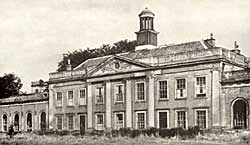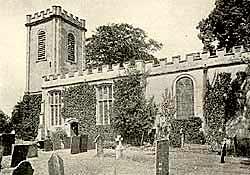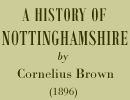< Previous | Contents | Next >
Colwick

Colwick Hall in the 1940s.
COLWICK occupies a pleasant secluded position on the riverside, near to Nottingham. The stately hall is a striking specimen of architecture, while the ivy-clad church contains some costly memorials of the dead. William Peverel, the Norman adventurer, was one of the first owners of Colwick. In his day there was in the village a priest and a church, a mill, and half a piscary or fishing. The place was known as ‘Over’ and ‘Nether’ Colwick, and ‘Over’ came subsequently into the hands of a family which took its name from the parish, and held the property of the monarch by the service of twelve barbed arrows given to him when he came to Nottingham Castle. We have a glimpse of Reginald de Colwick in the Corporation records as one of the witnesses to the document by which, in November, 1225, certain tolls were let by the burgesses of Nottingham to their neighbours of Retford; and his name occurs again as Sir Reginald de Colwick, knight, in 1241, when he witnessed a charter by which Ralph de Rhodes confirmed a grant he had made to St. John’s Hospital.
In 1280 the jury found that Reginald de Colwick, the grandfather of William, lived a hundred years, and that he and Philip his son, father of William, had their park enclosed with hedge and ditch at their pleasure. In 1297 another William de Colwick was summoned under the general writ to perform military service in person with horses and arms in Scotland, the muster being held at Nottingham on July 7, 1297. This was the ill-fated force which encountered the Scots at Stirling, on September 11, and suffered defeat at the hands of Sir William Wallace. The owner of Colwick seems happily to have survived the perils of the fatal field, for he represented the county as Knight of the Shire in Parliament from 1297 to 1301.
In the course of the next thirty years, disputes arose as to the river rights, but an amicable arrangement was come to between Sir William, the owner of Colwick at that time, and the Mayor and Corporation, by an agreement dated June 29, 1330.
William de Colwick died in 1362, leaving behind a son, Thomas, and a daughter, Joan. Thomas died without issue, and the estate was carried by Joan to the Byron family, she being the second wife of Sir Richard Byron, of Clayton, in the county of Lancaster.
The old controversy about the river rights was reopened, and this time a royal commission was appointed, in 1383, to settle the dispute.

St John the Baptist, Colwick, c.1915. The church is now a roofless ruin.
The earliest monument is an altar-tomb on the north side of the chancel, having on the upper slab the incised effigies of Sir John Byron and his two wives, and an inscription at the feet, which is entirely illegible. Round the upper edge is a black-letter inscription, stating that the deceased knight was Steward of Manchester and Rochdale, and Lieutenant of the Forest of Sherwood, and that he ‘departed out of this transitorye lyffe’ May 3, 1576. It was to this worthy that Henry VIII. granted the site of the Priory of Newstead, in 1540. He was the grandnephew of the sturdy warrior who fought for Richmond at Bosworth Field, and is distinguished from other knights of the same Christian name in the family by the title of ‘Sir John Byron the Little with the great beard,’ though curiously enough, his effigy represents him without any beard at all. On the south side of the chancel is a lofty alabaster monument to the memory of Sir John Byron, Knight, son of Little Sir John. It bears the recumbent figures of Sir John in armour, wearing a long beard and moustache, and his wife in the costume of the period. Two columns rise from the front corners of the tomb, and are connected by entablatures surmounted by pinnacles at the back. In front are two laudatory verses, which must have sent a thrill of horror through the famous poet of the family. They run thus:
‘Let Fame with golden trumppet blast
The worthi prayers eternise
Of Sir John Byron, gentle knight,
Whose corps bylow these pictures lies.
Sir John hys sonne, for parent’s love,
Caused to erect this monument,
That virtues of his father dead
In future time it might present.’
Sir John died in 1609, and his two eldest sons having died without issue, the estates passed to his third son, likewise a Sir John, who married Margaret, daughter of Sir William Fitzwilliams, sometime Lord-Deputy of Ireland, and was buried here in 1623. Husband and wife died the same day. They had seven sons, one of whom, also a Sir John Byron, died in 1625, and was interred here, as was his daughter Alice, who erected a monument to her father’s memory.
These were the last of the family buried at Colwick, for the eldest son, Sir John Byron, a stalwart Cavalier, who was raised to the peerage as Baron Byron of Rochdale in 1643, sold the estate to Sir James Stonehouse, ‘and never got much above half the money for reason of the breaking out of the war.’ Sir James did not attempt to hold the property long, but disposed of it to Sir John Musters, an eminent London merchant, who took up his abode here. He repaired the church at great expense, and new built the chancel and steeple in 1684. There are monuments to him and other members of the family in the chancel, one of which is a female figure by Westmacott, erected to the memory of Sophia Catherine Musters, who died in 1819.
Before leaving the church special notice must be taken of one monument on the north side of the altar, visible in the dim religious light of the east end of the chancel, which has a peculiar interest surpassing that of any other. It is the life-sized figure of a beautiful female, and is to the memory of the ‘Mary’ of Lord Byron’s poems, to whom in his youthful days he was so much devoted. Moore speaks of the perfect innocence and romance which distinguished the poet’s early love for Miss Chaworth, and describes her as a lady of much personal beauty, and a disposition the most amiable and attaching. Lord Byron himself, in a letter, says, ‘Our union would have healed feuds in which blood had been shed by our fathers, it would have joined lands broad and rich, and it would have joined at least one heart and two persons not unmatched in years.’ Miss Chaworth had, however, been smitten by the undoubted personal attractions of Mr. John Musters, the owner of Colwick, and Byron had to bid a sad adieu to all his hopes and anticipations. She was married in August, 18o5, and Byron could only lament that
‘Now no more the hours beguiling,
Former favourite haunts I see,
Now no more my Mary smiling,
Makes ye seem a heaven to me.
Mrs. Musters was at Colwick when the great Reform riots took place in the winter of 1831, resulting in the burning of Nottingham Castle, and received a fright when the mob looted the hall, which, along with the exposure to which she was subjected by having to take refuge in the shrubbery, is said to have hastened her death in February, 1832. Mr. Musters died in 1849, and was succeeded by his grandson, Mr. John Chaworth Musters, who died in 1888. He was succeeded by his son, Mr. J. P. Chaworth Musters, who has recently sold the Colwick estate to Colonel Horatio Davies, of London, and Wateringbury House, Kent. The old hall, the residence of the Byrons, was taken down in 1775, and the present fabric built upon its site the following year by Mr. Samuel Stretton, father of the antiquary, under the direction of Mr. John Carr, architect, of York.
